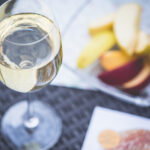 For those of us who love La Belle France, the images of the Loire Valley are indelible. A quiet, meandering, soulful river. Sleepy overhanging trees. Gorgeous medieval and Renaissance chateaux in timeless majesty for many miles. Glorious briny oysters at the western end of the river near the ocean and Nantes…seductive charcuterie everywhere…not to mention beautiful cheeses (among which the Loire goat cheeses are the most well-known, especially Crottin de Chavignol).
For those of us who love La Belle France, the images of the Loire Valley are indelible. A quiet, meandering, soulful river. Sleepy overhanging trees. Gorgeous medieval and Renaissance chateaux in timeless majesty for many miles. Glorious briny oysters at the western end of the river near the ocean and Nantes…seductive charcuterie everywhere…not to mention beautiful cheeses (among which the Loire goat cheeses are the most well-known, especially Crottin de Chavignol).
And wine. And wine. Bien sur.
Which wine? Well, for all of the foods mentioned above, the first local wines that come to mind are white, indubitably. The grace and elegance of the area seem to call out for white wines. And oh does the Loire have them in spades: Muscadet, Vouvray, Savennières, Sancerre, Pouilly-Fumé, Quincy, Menetou-Salon, and many others. These are, in fact, some of the crispest, tingliest, most food-loving white wines in the world.
But hold on, Gaston. In case you’re thinking of limiting your Loire Valley wine selections to white wines perhaps you’d better consider the alternative, as I have many a time when gathering a Loire picnic. Because, truth be told, some of the greatest of all Loire wines are red!
For starters, I’ve long been fascinated by Loire Valley reds made from Pinot Noir. Say “Sancerre,” and of course the first wine anyone pictures is white Sancerre, made from Sauvignon Blanc grapes. Most people are not even aware that Pinot Noir was planted in this area in the Middle Ages, even before it was planted in Burgundy. And that there’s also a red Sancerre appellation, reserved for Pinot Noir!
 How does red Sancerre differ from red Burgundy? Most important: don’t be thinking of Grand Cru Burgundy…or even Premier Cru Burgundy! These Sancerres are extremely light and crisp red wines, superb for light French bistro foods of all stripes. Of course, the chalky soil in this area does give red Sancerre some little flavor boosts that add to the fun: chalky, spicy, earthy, peppery, along with the basic cranberry-raspberry fruit. Remember, these wines are not played by church organs…think piccolos instead.
How does red Sancerre differ from red Burgundy? Most important: don’t be thinking of Grand Cru Burgundy…or even Premier Cru Burgundy! These Sancerres are extremely light and crisp red wines, superb for light French bistro foods of all stripes. Of course, the chalky soil in this area does give red Sancerre some little flavor boosts that add to the fun: chalky, spicy, earthy, peppery, along with the basic cranberry-raspberry fruit. Remember, these wines are not played by church organs…think piccolos instead.
For church organs (but only the ones in moderate-sized churches)…look to the Loire’s greatest red-wine grape, Cabernet Franc. Many years ago, when I first visited the area, I asked a local grower what distinguishes Cabernet Franc from Cabernet Sauvignon. “Franc!” he said. “We are Franc!”—implying some kind of connection between the wine he grows, the nationality he is, and a purported local tendency towards honesty. “We have none of that Sauvignon bullsheet here!”
Trying to make sense out of his words…I figured that the big-deal estates of Bordeaux’s left bank are bullsheet, he felt. In the Loire, he seemed to be saying, we make wine without a lot of glitz. Furthermore, while most of the world (led by the Americans) turns away from Cabernets that have hints of “green” in their flavor profiles, the Loire reds made from Cabernet Franc remain stalwartly green…or “Franc” in his opinion, varietal wines not glossed up by the bullsheet of new oak.
The most famous Cabernet Franc appellation in the Loire is Chinon, some of which can age a good 20 or 30 years into complexity. To the north is the slightly more rustic Bourgeuil, and a third appellation, Saint-Nicolas-de-Bourgeuil. To the west are Saumur-Champigny, and Saumur Rouge…the Cabernet Franc bargains of the Loire.
Tomorrow, I will give you a glimpse of one of my Loire red faves…along with a French main-course dish that will accommodate it perfectly. No bullsheet.




